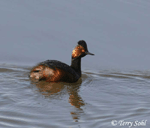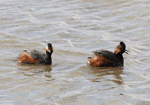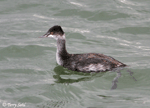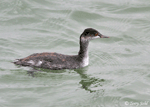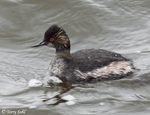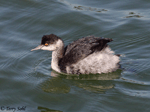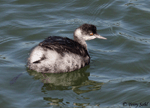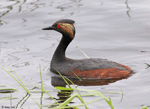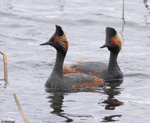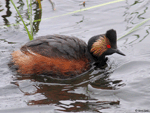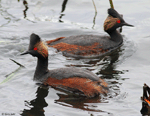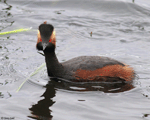Eared Grebe
Podiceps nigricollis
| Length: 12.5 inches | Wingspan: 22 inches | Seasonality: Summer |
| ID Keys: Summer plumage in South Dakota is black neck with gold ear tufts | ||
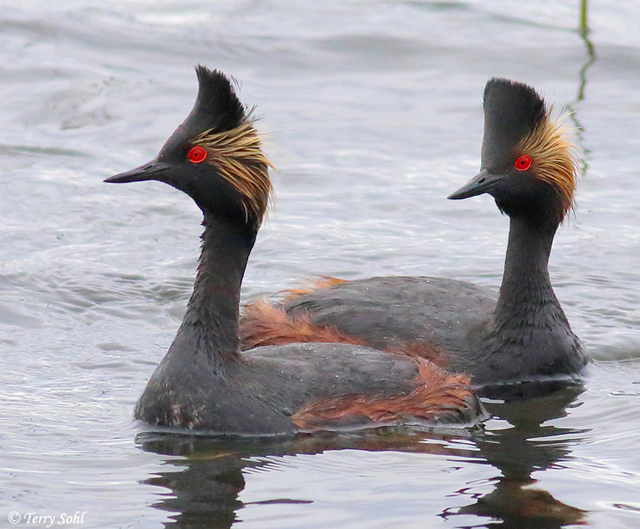 Eared
Grebes are a fairly common grebe in the state, more so than
the similar Horned Grebe. They are
also found in parts of Europe and Asia, where they are called the "Black-necked
Grebe". They are a very gregarious bird, often breeding in very
large colonies, and often migrating together in huge flocks. The
"ear" of the Eared Grebe is a tuft of gold feathers behind the eye
that appears during breeding season. The photo on the right is of a pair
of birds
in breeding plumage. Neck color is a distinguishing mark used to differentiate
summer plumage Eared Grebes and Horned Grebes.
Eared
Grebes are a fairly common grebe in the state, more so than
the similar Horned Grebe. They are
also found in parts of Europe and Asia, where they are called the "Black-necked
Grebe". They are a very gregarious bird, often breeding in very
large colonies, and often migrating together in huge flocks. The
"ear" of the Eared Grebe is a tuft of gold feathers behind the eye
that appears during breeding season. The photo on the right is of a pair
of birds
in breeding plumage. Neck color is a distinguishing mark used to differentiate
summer plumage Eared Grebes and Horned Grebes.
Habitat:
Eared Grebes breed on sloughs, marshes, or shallow ponds and lakes with with herbaceous wetland vegetation. They are typically found in open habitats, not forested lakes and ponds. In winter they can be found on both coastlines and inland saline lakes and ponds.
Diet:
The diet of an Eared Grebe consists mostly of aquatic insects and crustaceans, and occasionally tadpoles, small frogs, and small fish.
Behavior:
Feeds by diving underwater and propelling itself by its feet. Will also take food items from the surface of the water.
Nesting:
June and July. As with some other grebe species, the breeding season begins with elaborate courtship rituals. The prospective pair call back and forth and approach other, often diving simultaneously, coming up, and posturing for each other. The pair may make extended "dances" that consist of rising up in the water and furiously paddling in an upright posture across the surface with necks raised.
Eared Grebes are colonial nesters, often nesting in very close proximity to each other. The nest itself is a platform of vegetation that floats above the water's surface. It's built of wetland vegetation and anchored to cattails and other surrounding vegetation. The female lays between 2 and 8 eggs, with both parents helping to incubate them. Incubation lasts about 3 weeks, and within a couple of hours of hatching, the young can leave the nest with the parents, are are capable of swimming and foraging on their own. They often ride on the backs of their parents for the first couple of weeks until the young are better able to take care of themselves.
Song:
The typical call heard during the breeding season is a risking oooEEEK, ending with a muted clicking sound. They also have a rising whistling call.
- Click here to hear the typical breeding season call of an Eared Grebe1
- Click here to hear the begging calls of young Eared Grebes2
- Click here to hear the whistling call of an Eared Grebe3
Migration:
Summers on interior lakes of the west and northern plains, summers along the Pacific Coast, the Gulf Coast, and Mexico.
Interactive eBird Map:
Click here to access an interactive eBird map of Eared Grebe sightings
Similar Species:
There's one species often confused with Eared Grebes, and a couple of other grebe species that could potentially be confused with Eared Grebes dependent upon season:
- Horned Grebe - In breeding plumage, Horned Grebes share the overall dark colors, red eye, and head plumes of an Eared Grebe. However, the "horned" plumage on a Horned Grebe flows back in one direction behind and above the eye, while the plumes on an Eared Grebe are splayed out more broadly. The neck of a breeding plumaged Horned Grebe is a rich rusty color, while the neck of an Eared Grebe is black. Non-breeding birds are more difficult, as they lose the dark coloring and the head plumes. Non-breeding Horned Grebes have a "cleaner" plumage appearance, with a clear demarcation between a dark top half and white lower half of the head. The dark part of the head reaches further down on an Eared Grebe, and the transition to a lighter chin and neck is messier.
- Pied-billed Grebe - The most common of the Grebe species on this list (in South Dakota), Pied-billed Grebes have thicker bills that are quite different than those of an Eared Grebe. In breeding plumage, that bill has a clear dark band around it, compared to the all dark bill of an Eared Grebe. Breeding plumaged birds of the two species aren't likely to be confused, but the plainer winter plumaged birds could be. Non-breeding Pied-billed Grebes are dark overall and lack the lighter white neck and underparts of a non-breeding plumaged Eared Grebe.
- Red-necked Grebe - Red-necked Grebes are larger than Eared Grebes. Breeding plumaged birds aren't likely to be confused. Non-breeding plumaged birds are both dark above and lighter below, with a lighter neck. However, the bill on a Red-necked Grebe is longer and yellow, while that of an Eared Grebe is much smaller and gray.
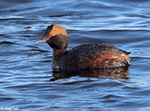 |
 |
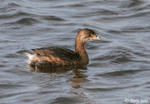 |
 |
| Horned Grebe (breeding plumage) | Horned Grebe (Spring plumage in transition) | Pied-billed Grebe (non-breeding plumage) | Red-necked Grebe (breeding plumage) |
Conservation Status:
There are no discernible overall trends in populations from systematic surveys in the US, such as the Breeding Bird Survey. They are found across a very broad geographic area (both in North America, and in Europe and Asia), are common in parts of that range, and have very high global populations. The IUCN considers the Eared Grebe to be a species of "Least Concern".
Further Information:
- USGS Patuxent Bird Identification InfoCenter, Eared Grebe
- Audubon Guide - Eared Grebe
- Whatbird.com: Eared Grebe
Photo Information:
May 20th, 2018 - Weisensee Slough, Minnehaha County, South Dakota -- Terry Sohl
Additional Photos:
Click on the image chips or text links below for additional, higher-resolution Eared Grebe photos.
Audio File Credits:
- 1Peter Ward and Ken Hall. Recorded in Cariboo, British Columbia on May 23rd, 1984. Original recording and information available from xeno-canto.
- 2Patrik Aberg. Recorded in Naturum at Lake Hornborga, Sweden on July 24th, 2020. Original recording and information available from xeno-canto.
- 3Marco Dragonetti. Recorded in Romania on June 26th, 2014. Original recording and information available from xeno-canto.
| Click on the map below for a higher-resolution view |
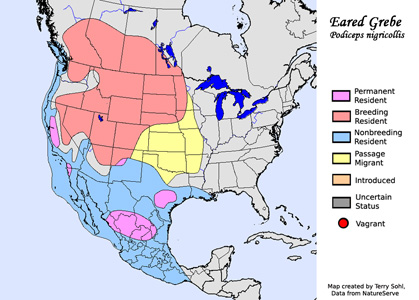 |
| South Dakota Status: Common migrant throughout the state. Common summer resident in the eastern part of the state. |
Additional Eared Grebe Photos
Click for a higher-resolution version of these photos
